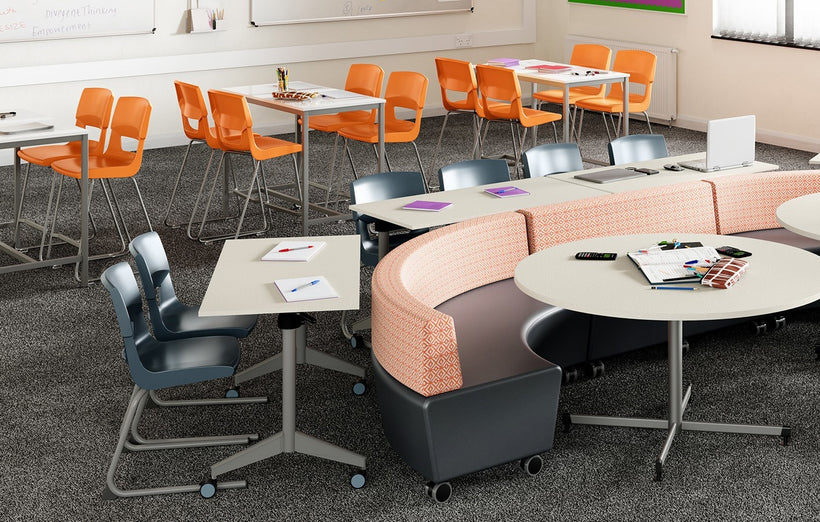Designing Interactive Learning Spaces: A guide to Classroom Layouts
by Wade Larkin on

Intentionally designed learning spaces improve classroom participation. Active learning is key here. Over the last few decades, teaching has moved from a ‘broadcast’ model, where a scheduled curriculum is delivered by an expert to a more active learning model. Created through multiple roles to play, interaction and engagement, allowing for enhanced learning through ownership.
A large part of active learning is unsurprisingly dependent on the flexibility of the classroom layout. From roundtable classrooms that facilitate open dialogue, breakout spaces for smaller discussions to desks on gliders and swivel chairs that allow a space to change instantaneously. Flexible classrooms can significantly affect attention, motivation, and achievement.
‘They should be meaningful, connecting to kids’ previous experiences and knowledge. They should prompt social interaction with caregivers and friends. They should be iterative – updating understanding based on new information – rather than repetitive. And finally, they should be joyful and generate positive feelings or a sense of surprise.’ How to design a public play space where kids practice reading and STEM skills (theconversation.com)
Human Centred Design Creates New Learning Opportunities
Human centred design focuses on the intersections between people, design, and empathy. Empathy for the human perspective of those who utilise an environment is expressed through the following problem-solving process.
- Empathy: Understanding the needs, emotions and desires of students and teachers.
- Ideate: Solutions are centred around catering to needs and addressing pain points.
- Prototype: Layouts are tested in real-life learning environments
- Feedback Loop: Continuously gather feedback and iterate on designs.
Engaging Layouts
‘The traditional layout of auditoria and lecture halls has rarely provided for social engagement among students. No doubt we all have many classrooms whose floor plans look the same. This arrangement is not conducive to discussion among students; the design optimises instructor transmission. In the traditional classroom floor plan, students receive content, packaged, and presented with a "one size fits all" approach, regardless of the learners' unique needs or styles’ Chapter 9. Trends in Learning Space Design | EDUCAUSE
Rethinking learning spaces, in particular, how informal learning spaces are far more conducive to a greater sense of ownership and an enhanced motivation to learn for students, has led to the introduction of flexible classroom floor plans and therefore adaptable classroom furniture.
Promoting Active Learning and Participation.
A classroom layout can either enhance or hinder active learning. In the action of doing, students become engaged. This is by far the biggest benefit of active learning. Students move from short-term retention to achieving deeper levels of understanding. Collaborative and critical thinking are the outcomes. Skills that are needed far beyond the classroom.
Design for Active Learning:
Flexible Seating: Creating experimental classroom designs depends on the innovative use of furniture. Swivel chairs and tables on gliders allow such flexibility. The Twist’n’Lock family by Sebel are perfect for creating flexible seating classrooms. Polypropylene legs and pin-less adjustments allow these tables to be easily height-adjustable with a simple twist and lock motion. While castor feet allow for easy re-configuration to creative collaborative environments.
Tech Integration:
The digital world offers new and novel ways to transmit learning. Equip spaces with modern tech tools like interactive whiteboards, tablets, and collaboration software to promote interactive learning. Artome M10+ is the meeting point of this technology, offering a high-quality audiovisual experience in beautifully designed furniture.
Zoning Areas:
Designate areas for different learning modes - swivel chairs allow the flexibility to change up a space quickly. RBM’s Noor 6070 is ideal for creating both group discussion pods and individual workstations. Available in a variety of upholstery options and colour finishes, these Scandinavian style chairs are not only comfortable but will bring life to any room in their vibrant colours.
Impact of Furniture Choices
A 2012 study conducted by the University of Minnesota discovered that when flexible classroom layouts were implemented, 48% more students were actively participating in open discussions. Tying back to the ownership element of flexible classrooms - students feel like they are creating their own learning environment.
A table that is mobile, foldable, and height-adjustable desk system that doesn’t require electrical connection, allows students this level of ownership. The Talent 500 table by Actiu revolutionises learning environments that demand adaptable table solutions.
Design Elements
Lighting: Light not only boosts student productivity, correct well-lit spaces also enhance wellbeing. Adjustable lighting, made for differing learning situations, takes this one step further. Luxxbox Vapor Echo maintains comfortable levels of sound in any space and with inset LED lights is also a perfect lighting aid. Built with lightweight acoustic panels, Hush lights soften the impact of noise in educational spaces by absorbing excess sound.
Acoustics: Soundproofing goes a long way to preventing outside distractions and creating more intimate learning spaces. Consider the noise generated within the learning environment and design to minimise. Autex Acoustic’s Composition Peel 'n' Stick Tiles is such a solution. The pin able and moveable surface lends itself to creative and educational spaces.
Colour: Colours impact emotion, mood, and concentration. The use of bright colours can be attention-grabbing. This is useful in highlighting important information and drawing attention to specific learning tools. Colours can also stimulate emotions. Blues and greens have a calming effect and could be used in breakout spaces where focus is key.
Innovation is never complete. As the world around us changes and research builds on emerging teaching methodologies - there will always be a need to be ready to adapt and innovate.
The future of education is rightly shifting towards interactive, student-centred learning experiences. By shifting focus to human-centred design principles and emphasising active learning, we can create classroom spaces that are more than just rooms; they become dynamic environments full of discovery, engagement, and most importantly, learning.
